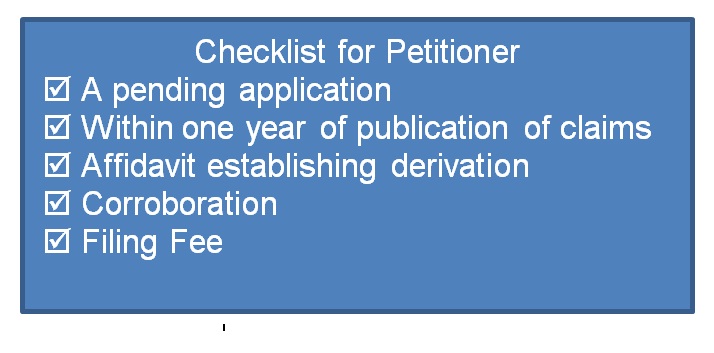Institution Decisions
In Microsoft Corporation v. VirnetX, Inc., IPR2014-00610, Paper 9 (October 15, 2014) the Board instituted inter partes review of claims 1, 2, 6–8, and 12–14 of U.S. Patent No. 7,490,151.
In Microsoft Corporation v. VirnetX, Inc., IPR2014-00615, Paper 9, Case IPR2014-00612, Patent No. 9, IPR2014-00613, Paper 9, and IPR2014-00614, Paper 9, (October 15, 2014), the Board instituted inter partes review of claims 1, 2, 6, 14–17, 19–23, 26–41, 43–47, and 50–60 of U.S. Patent No. 7,418,504 (all of the challenged claims) and consolidated those proceedings.
In Microsoft Corporation v. VirnetX, Inc., IPR2014-00615, Paper 9, Case IPR2014-00616, Patent No. 9, IPR2014-00618, (October 15, 2014) the Board denied inter partes review of 1, 2, 6, 14–17, 19–23, 26–41, 43–47, and 50– 60 of U.S. Patent No. 7,921,211 (43 claims) in IPR2014-00616. but instituted inter partes review in IPR2014-00615 and IPR2014-00618, and consolidated those proceedings.
In Ford Motor Company v. Vehicle Operation Technologies, LLC., IPR2014-00594, Paper 26 (October 15, 2014), the Board instituted inter partes review of claims of claims 1–15, 21–28, and 41–44of U.S. Patent No. 7,145,442 (all 27 of the challenged claims).
In Ford Motor Company v. Vehicle Operation Technologies, LLC., IPR2014-00600, Paper 26 (October 15, 2014), the Board instituted inter partes review of claims of claims 1–15, 21, 22, 24–28, and 41–44 of U.S. Patent No. 7,145,442 (all 36 of the challenged claims).
In BMW North America, LLC v. Vehicle Operation Technologies, LLC., IPR2014-00601, Paper 26 (October 15, 2014), the Board instituted inter partes review of claims of claims 1–15, 21, 22, 24–28, and 41–44 of U.S. Patent No. 7,145,442 (all 36 of the challenged claims).
In BMW North America, LLC v. Vehicle Operation Technologies, LLC., IPR2014-00602, Paper 26 (October 15, 2014), the Board instituted inter partes review of claims of claims 1–15, 21, 22, 24–28, and 41–44 of U.S. Patent No. 7,145,442 (all 36 of the challenged claims).
In BMW North America, LLC v. Vehicle Operation Technologies, LLC., IPR2014-00603, Paper 30 (October 15, 2014), the Board instituted inter partes review of claims 1–15, 21–28, and 41–44 of U.S. Patent No. 7,145,442 (all 27 of the challenged claims).
In The Gillette Company v. Zond LLC, IPR2014-00604, Paper 9 (October 15, 2014), the Board instituted inter partes review of claims 30–37 of U.S. Patent No. 6,896,775.
In Fujitsu Semiconductor Limited v. Zond LLC, IPR2014-00846, Paper 12 (October 15, 2014) the Board instituted inter partes review of claims 14–18 and 25–32 (all the challenged claims) of U.S. Patent No. 7,604,716.
In Fujitsu Semiconductor Limited v. Zond LLC, IPR2014-00849, Paper 11 (October 15, 2014) the Board instituted inter partes review of claims 19–24 (all the challenged claims) of U.S. Patent No. 7,604,716.
In Taiwan Semiconductor Manufacturing Company, Ltd. v. Zond LLC, IPR2014-00807, Paper 10 (October 15, 2014) the Board instituted inter partes review of claims 14–18 and 25–32 (all the challenged claims) of U.S. Patent No. 7,604,716.
In Taiwan Semiconductor Manufacturing Company, Ltd. v. Zond LLC, IPR2014-00808, Paper 9 (October 15, 2014) the Board instituted inter partes review of claims 19–24 (“the challenged claims”) of U.S. Patent No. 7,604,716.
In IGB Automotive Ltd. v. Gentherm GmbH, IPR2014-00667, Paper 7 (October 15, 2014), the Board instituted inter partes review of claims 1–6 (all of the challenged claims) of U.S. Patent No. 7,637,573.
Joinder
In Fujitsu Semiconductor Limited v. Zond LLC, IPR2014-00846, Paper 12 (October 15, 2014) the Board granted petitioner’s motion to join the proceeding with IPR2014-00808.
In Fujitsu Semiconductor Limited v. Zond LLC, IPR2014-00849, Paper 12 (October 15, 2014), the Board granted petitioner’s motion to join the proceeding with IPR2014-00807.
Rehearing
Catapult Innovations Pty Ltd. v. adidas AG, DER2014-00005, Paper 15, DER2014-00006, Paper 21 (October 15, 2014), the Board denied rehearing of the Board’s decision denying institution of a derivation proceeding.


